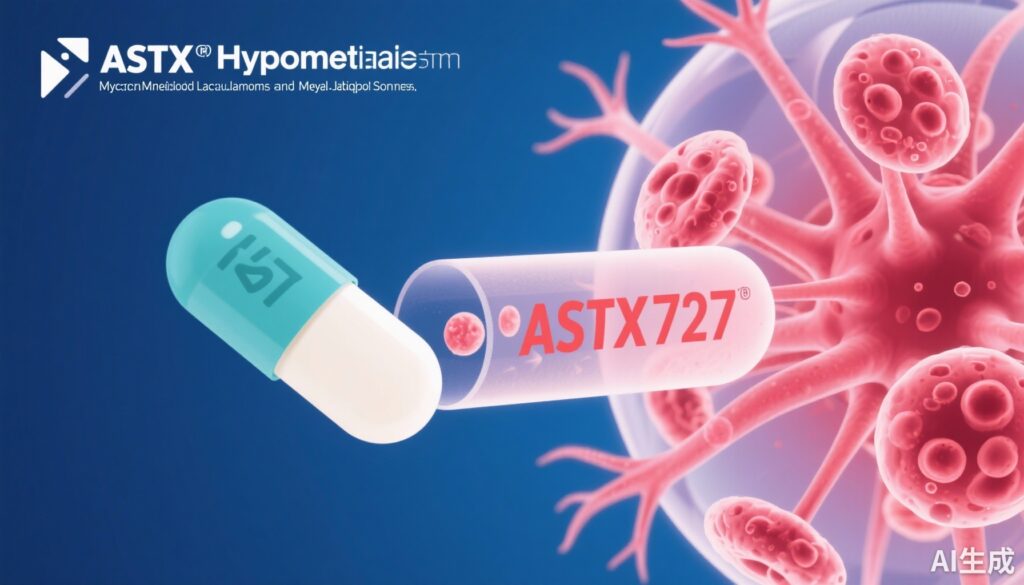Study Background and Disease Burden
Acute myeloid leukaemia (AML) and myelodysplastic syndrome (MDS) are clonal hematological malignancies characterized by ineffective hematopoiesis and risk of progression to bone marrow failure or leukemic transformation. Allogeneic haematopoietic stem-cell transplantation (HSCT) remains a potentially curative option, particularly for patients with high-risk disease features. However, relapse post-HSCT is the leading cause of treatment failure and mortality, especially in patients categorized as very high risk, defined by adverse genetic, molecular, or clinical prognostic factors. Despite advancements in transplantation strategies, relapse rates remain substantial, underscoring the unmet need for effective maintenance therapies to sustain remission and improve long-term outcomes.
Hypomethylating agents (HMAs) such as decitabine have demonstrated efficacy in AML and MDS by reversing aberrant DNA hypermethylation, restoring tumor suppressor gene expression, and inducing cellular differentiation or apoptosis. Incorporating HMAs as maintenance therapy post-HSCT aims to prevent relapse by targeting residual leukemic clones. Oral formulations, such as the combination of decitabine and cedazuridine (ASTX727), a cytidine deaminase inhibitor enhancing decitabine bioavailability, offer convenient administration compared to parenteral routes, potentially improving adherence and quality of life. Previous studies combining HMAs with donor lymphocyte infusion (DLI) suggest synergistic immunomodulatory effects that might further reduce relapse risk.
Study Design
The GFM-DACORAL-DLI trial is a multicentre, single-arm, phase 2 study conducted at 12 centres in France. It enrolled adult patients aged 18-70 years with an Eastern Cooperative Oncology Group (ECOG) performance status of 0 to 2 who were indicated for allogeneic HSCT and had very high-risk AML or MDS. Very high-risk classification included poor or very poor prognosis per the revised International Prognostic Scoring System for MDS and adverse risk per the 2017 European LeukemiaNet classification for AML, along with other criteria such as unfavorable genetics and early relapse after prior remission.
Patients were recruited between 5 and 45 days prior to transplantation. From day 40 post-HSCT, patients received oral ASTX727 administered in escalating doses starting at 100 mg cedazuridine plus 35 mg decitabine for 1 day per cycle, increasing up to 3 days, with a maximum of ten cycles. Donor lymphocyte infusions were recommended for patients without contraindications after completion of cycle 4, aiming to enhance the graft-versus-leukemia effect.
The primary endpoint was disease-free survival (DFS) at 1 year after HSCT, evaluated in the first 28 patients treated with ASTX727. Secondary endpoints included overall survival, safety, tolerability, and treatment adherence. Safety was assessed in all patients receiving at least one cycle of ASTX727. Registration was completed under ClinicalTrials.gov identifier NCT04857645.
Key Findings
Out of 59 screened patients, 51 proceeded to undergo allogeneic HSCT (median age 62 years, interquartile range 56.5-65.0; 43% female). Among them, 34 patients received maintenance with ASTX727; seven of these also received at least one dose of donor lymphocyte infusion.
Only 41% (14 patients) completed the planned ten cycles of maintenance therapy, indicating challenges in treatment continuation that may relate to toxicity or other clinical factors. Median follow-up was 12.6 months.
Focusing on the first 28 patients treated with ASTX727, 1-year DFS post-HSCT was 70.4% (95% confidence interval [CI] 55.1%-89.9%). This represents a promising survival outcome in a cohort with historically poor prognosis. The data suggests potential activity of oral decitabine and cedazuridine as a maintenance strategy.
Safety assessment showed that grade 3 or higher adverse events were predominantly hematological: neutropenia (62%), thrombocytopenia (24%), and anemia (12%). Serious adverse events occurred in 41% of patients, mostly hematological and gastrointestinal in nature. There was one treatment-related death attributed to thrombocytopenia, emphasizing the need for careful monitoring during therapy.
Expert Commentary
The GFM-DACORAL-DLI study contributes valuable evidence supporting the feasibility of oral, hypomethylating-agent-based maintenance after HSCT in very high-risk AML and MDS populations. The oral route introduces patient convenience and potentially higher compliance compared to intravenous or subcutaneous methods.
The observed 1-year DFS of approximately 70% compares favorably to historical controls, although definitive conclusions must be cautious given the single-arm design without a randomized comparator. The tolerability profile, while manageable, highlights significant hematological toxicity, necessitating attentive hematopoietic monitoring and supportive care.
The optional addition of donor lymphocyte infusion is biologically plausible to enhance graft-versus-leukemia effects; however, only a minority received this treatment, limiting subgroup analyses of its incremental benefit.
Limitations include the relatively small sample size, incomplete therapy completion rate, and short median follow-up. Additionally, variability in dosing duration and patient heterogeneity might affect generalizability.
Conclusion
Maintenance with oral decitabine and cedazuridine (ASTX727) starting around day 40 post-allogeneic HSCT shows promise in improving disease-free survival among patients with very high-risk AML or MDS. The regimen is associated with expected hematological toxicities but is overall manageable.
Further randomized controlled trials are needed to confirm these results, optimize dosing strategies, integrate donor lymphocyte infusion protocols, and better define patient selection to maximize therapeutic benefit. If validated, this approach may establish a new paradigm for maintenance therapy after HSCT in high-risk myeloid malignancies, potentially reducing relapse rates and improving long-term survival.
References
Robin M, D’Aveni M, Stamatoullas A, et al. Oral decitabine and cedazuridine maintenance after haematopoietic stem-cell transplantation in very high-risk acute myeloid leukaemia or myelodysplastic syndrome (GFM-DACORAL-DLI): a multicentre, single-arm, phase 2 trial. Lancet Haematol. 2025 Sep;12(9):e705-e716. doi: 10.1016/S2352-3026(25)00172-3. Epub 2025 Aug 7. PMID: 40784355.



